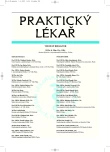Family occurrence of type E hepatitis due to primary foodborne infection
Authors:
J. Pazderková 1; J. Sajbertová 1; P. Dlouhý 1; J. Trmal 2; J. Krejčí 3
Authors‘ workplace:
Infekční oddělení Masarykovy nemocnice, Ústí nad Labem
Primář: MUDr. P. Dlouhý
1; Zdravotní ústav se sídlem v Ústí nad Labem
Ředitel: Ing. Pavel Kutil
2; Výzkumný ústav veterinárního lékařství, Brno
Ředitel: prof. MVDr. Miroslav Toman, CSc.
3
Published in:
Prakt. Lék. 2009; 89(5): 265-267
Category:
Case Report
Overview
The authors describe the endemic occurrence of type E hepatitis. The case described was initially a foodborne infection, and continued to spread through the family. They emphasize above all that it is necessary to consider this aetiology even in our conditions. It is particularly relevant in the cases of acute hepatitis, where type A, B and C hepatitis have been excluded. They recommend integration of a serological test to detect antibodies against this virus into the algorithm for diagnosis of acute parenchymal hepatic diseases. Furthermore, they highlight an epidemiologically significant fact that the source of infection may be, in addition to contaminated water, food of animal origin.
Key words:
hepatitis E, epidemiology, foodborne infection, family occurrence.
Sources
1. Balayan, M.S., Andjaparidze, A.G., Savinskaya, S.S. et al. Evidence for a virus in non-A, non-B hepatitis transmitted via the fecal-oral route. Intervirology 1983, 20, p.23-31.
2. Clayson, E.T., Myint, K.S., Snitbhan, R. et al. Viremia, fecal shedding, and IgM and IgG responses in patients with hepatitis E. J. Infect. Dis. 1995, 172, p. 927-933.
3. Clemente-Casares, P., Pina, S., Buti, M. et al. Hepatitis E virus epidemiology in industralized countries. Emerg. Infect. Dis. 2003, 9, p. 448-454.
4. Emerson, S.U., Anderson, D., Arankalle, A.V. et al. Hepavirus. In: Fauquet, C.M., Mayo, M.A., Maniloff, J., et al. (eds.): Virus taxonomy. The eight report of the international comittee on taxonomy of viruses. London: Elsevier/Academic Press, 2004, p. 851-855.
5. Mushahwar, I.K. Hepatitis E virus: molecular virology, clinical features, diagnosis, transmission, epidemiology, and prevention. J. Med. Virol. 2008, 80, p. 646-658.
6. Schwartz, J.M., Ingram, K., Flora, K.D. Hepatitis E. eMedicine Gastroenterology. Dostupné na WWW: http://emedicine.medscape.com/article/178140.
7. Tamada, Y., Yano, K., Yatsuhashi, H., et al. Consumption of wild boar linked to cases of hepatitis E. J Hepatol. 2004, 40, p. 869-870.
8. Vasickova, P., Psikal, I., Kralik, P., et al. Hepatitis E virus: a review. Vet. Med. 2007, 52, p. 365-384.
9. Vasickova, P., Psikal, I., Widen, F. at al. Detection and genetic characterisation of Hepatitis E virus in Czech pig production herds. Res. Vet. Sci. 2009, (in press).
10. Vishwanathan, R. Infectious hepatitis in Delhi (1955-1956): a critical study. Ind. J. Med. Res. 1957, 45, p. 1-30.
11. Yamane, I. Epidemics of emerging animal diseases and food-borne infection problems over the last 5 years in Japan. Ann. N.Y. Acad. Sci. 2006, 1081, p. 30-38.
12. Yazaki, Y., Mizuo, H., Takahashi, M. et al. Sporadic acute or fulminant hepatitis E in Hokkaido, Japan, may be food-borne, as suggested by the presence of hepatitis E virus in pig liver as food. J. Gen. Virol. 2003, 84, p. 2351-2357.
Labels
General practitioner for children and adolescents General practitioner for adultsArticle was published in
General Practitioner

2009 Issue 5
Most read in this issue
- Influence of hormonal contraception on thyroid gland diseases
- Chronic kidney disease – a role of nephrologists and general practitioner
- Occupational diseases of the ulnar nerve reported in the Hradec Králové region
- Functional assessment (diagnostics) in rehabilitation
